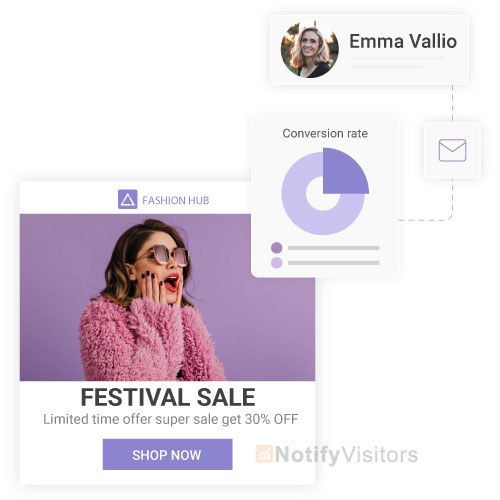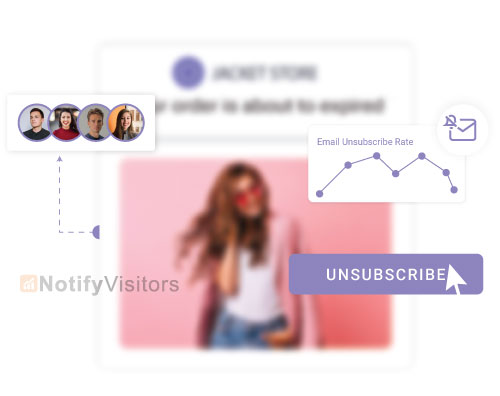Are you looking for ways to measure the success of your email marketing campaigns? If yes, then it is time to start tracking key performance indicators (KPIs).
Email marketing KPIs allow us to understand how effective our quantified efforts are, whether we need improvement and what tactics work best in accomplishing our goals.
In this blog post, we’re going to go over the 13 essential email marketing KPIs that you should be focusing on in 2025–and beyond!
Contents
13 Email Marketing KPIs You Should Track
1. Click-through rate

The click-through rate (CTR) KPI calculates the percentage of email recipients who click on email links or CTA in marketing emails concerning the total number of times you sent the email.
It shows how effectively your email campaigns drive interest and engagement from email subscribers.
The CTR doesn’t count multiple clicks from the same user; instead, it only accounts for unique clicks for each email. That way, you get accurate data even if there are multiple clicks by one email.
Therefore, you’ll get a more authentic insight into who engages best with your content. The click-through rate should be different from the click-to-open (CTO) rate.
A click-through rate calculates data based on the total number of emails sent, while a click-to-open rate calculates data based on the total number of opened emails.
2. Email Open rate

The email open rate calculates the percentage of people who opened your email compared to the total emails sent.
The average open rate is 11 to 50%, so if your open rate is more than that, that’s a great sign. Higher open rates imply that your subject lines and preheader text effectively engage consumers and drive them to open your emails.
However, if the open rate is low, you should review your email campaigns’ subject lines and preheader text.
The objective should be to make them more effective, engaging, and personalized to stand out in a flooded inbox.
Low open rates usually occur when brands or businesses make email marketing mistakes without feeling the interests or behaviors of their targeted audience segments.
3. Conversion rate

The email conversion rate KPI calculates the percentage of email subscribers who take the needed action, like clicking on a link or buying from an online store.
If your emails engage and inspire readers to click on a link, you can expect more leads to convert into customers and achieve higher conversions.
Enhancing your emails’ conversion rate needs enhancing the email content, providing clear and concise calls to action, and A/B testing various versions of your emails.
Moreover, you can apply the below-mentioned techniques to enhance the conversion rate for future campaigns:
- Make sure your email messages are mobile-responsive
- Personalize the content to improve email performance
- Make use of customer journey optimization to enhance conversions of link clicks
- Incorporate visuals, images, and videos to grab attention and convert leads into customers.
Keep in mind that your email list conversion rate is directly influenced by how customers resonate with your email marketing campaign content.
4. Email sharing & forwarding rate
Email sharing & forwarding rate is the percentage of users who clicked the share button or forwarded your email. The best email marketing aspect of this KPI is understanding which users like or share your content.
You can make emails with similar content to drive more leads based on the analysis.
The targeted one is already on your recipient list.
You can track how usually the email is shared or forwarded through that utilize. You must maintain a record of the content style that got you more shares and forwards.
5. Revenue per email
Email marketing is a very useful way to reach out to potential customers. However, to maximize the efficacy of email marketing, it is necessary to comprehend how to calculate revenue per email.
This email marketing KPI allows businesses to comprehend how much revenue they can forge from each email sent. By comprehending this metric, businesses can modify their email marketing strategy to drive more revenue.
Figuring out your revenue per email can assist you in assessing the efficacy of your email marketing campaigns and making decisions about where to assign your resources.
6. Email bounces
Email bounces are one of the most significant email marketing KPIs every savvy marketer must pay attention to.
A bounce happens when an email is sent to an invalid email address, or a soft bounce happens when an email is sent to a valid email address but is returned by the server.
A high bounce rate can imply that your email marketing campaigns are ineffective and that you are not reaching your target audience. In addition, a high bounce rate can also guide spam complaints.
As an email marketer, your job is to keep a low bounce rate. High email bounce rates can be a concern for businesses that rely on email marketing to reach their customers. It might lead to a decrease in sales and a loss of revenue for the organization.
How to prevent high email bounce rates
Here are a few things you should follow to avoid high email bounce rates:
- You have to ensure that your email list is updated. Remove any inactive or invalid email addresses.
- Utilize a double opt-in process to verify each email address on your list.
- Experiment with your email content before sending it out to your list. Send a test email to a small group of people to witness if they engage with your message.
7. Unsubscribe rate

The unsubscribe rate KPI calculates the number of people who unsubscribe or opt out of your email newsletters or campaigns by clicking on the unsubscribe link.
Higher unsubscribe rates can sometimes mean a problem with your email content or high-frequency sending issues.
To reduce this email marketing KPI and improve the delivery rate, carefully review the email format and content in your email campaigns and make sure they are helpful and relevant to your customers’ requirements.
Additionally, make sure that you’re sending only a few emails within a short time. It’s more helpful to send fewer but high-quality emails to a valid email address personalized for every customer segment.
8. Email deliverability rate
The email deliverability rate determines how many emails were delivered to the user’s inbox. Customers are believed to receive all the emails, but it is not always true. Sometimes, the email bounces back from the receiving servers.
There can be several reasons for that, which can lead to low deliverability. Here are some things that lead to a low deliverability rate:
- Making it difficult for users to unsubscribe
- Sending emails from a free-domain email address
- Missing custom authentication while sending the email.
A deliverability rate of 95% is considered the best.
9. List the growth rate
The email list growth rate is the percentage of email recipients opting to get your emails over a specific period.
A higher email list growth rate suggests that your email content resonates with readers and encourages them to subscribe, which signifies more leads and conversions in the future.
To improve this KPI, build an email sign-up form on your website and other marketing channels, such as social media.
You can also facilitate an affiliate program or partnership opportunity to improve your audience reach and subscriber potential.
Additionally, concentrate on building exciting email campaigns and leveraging newsletter management strategies that engage customers and inspire them to subscribe.
10. Spam complaint rate
The number of people who mark your email as spam is calculated under the spam complaint rate.
It is computed by dividing the number of spam complaints by the no. of emails sent.
Additionally, multiplying this number by 100 will provide you with the spam complaint rate
This number grows if the user finds your email irrelevant. Therefore, keep your emails noteworthy, relevant, and personalized. The acceptable spam complaint rate is 0.1%.
11. Email sharing rate
The email share rate shows the number of times an email is shared by its recipients. Email sharing is a popular way to disseminate information and create relationships with others.
When an email is shared, its sender can track how many times it was shared and who shared it.
Therefore, tracking how frequently your emails are shared is a savvy way to audit your email marketing efforts.
By comprehending how frequently your email is shared, you can modify your content and strategies to employ your audience better.
12. Return on investment
The ROI KPI calculates your email marketing campaigns’ ROI by comparing its costs to the revenue generated. It allows you to calculate the efficiency and profitability of your email marketing efforts over time.
To enhance email marketing ROI, utilize automated email marketing software to deliver personalized emails that resonate with consumers and minimize campaign costs.
13. Subscriber lifetime value
This email marketing KPI will help you comprehend your email marketing campaign’s impact on the user or the subscriber.
It is the average value of a user who is added to your email list for the whole period of the subscriber’s time on that list.
In short, it is important for a subscriber for the time they are active.
Conclusion
If you are looking to improve your email marketing in 2025, make sure to keep track of these 13 KPIs. By monitoring and optimizing your campaign according to these metrics, you can be assured that your email marketing will reach new heights this year!
FAQs
1. What are a few Email Marketing KPIs?
Here are a few email marketing KPIs that you need to track:
- Spam rate
- Click-through rate
- Conversion rate
- Email open rate
- Email share and Forwarding rate
- Email bounces
- Unsubscribe rate
2. What are common Email Marketing KPIs?
Here are a few common email marketing KPIs:
- Email open rate
- Conversion rate
- Click-through rate
- Email bounce rate
- Spam rate
- Email forwarding rate
Also Read:

























 Email
Email SMS
SMS Whatsapp
Whatsapp Web Push
Web Push App Push
App Push Popups
Popups Channel A/B Testing
Channel A/B Testing  Control groups Analysis
Control groups Analysis Frequency Capping
Frequency Capping Funnel Analysis
Funnel Analysis Cohort Analysis
Cohort Analysis RFM Analysis
RFM Analysis Signup Forms
Signup Forms Surveys
Surveys NPS
NPS Landing pages personalization
Landing pages personalization  Website A/B Testing
Website A/B Testing  PWA/TWA
PWA/TWA Heatmaps
Heatmaps Session Recording
Session Recording Wix
Wix Shopify
Shopify Magento
Magento Woocommerce
Woocommerce eCommerce D2C
eCommerce D2C  Mutual Funds
Mutual Funds Insurance
Insurance Lending
Lending  Recipes
Recipes  Product Updates
Product Updates App Marketplace
App Marketplace Academy
Academy
